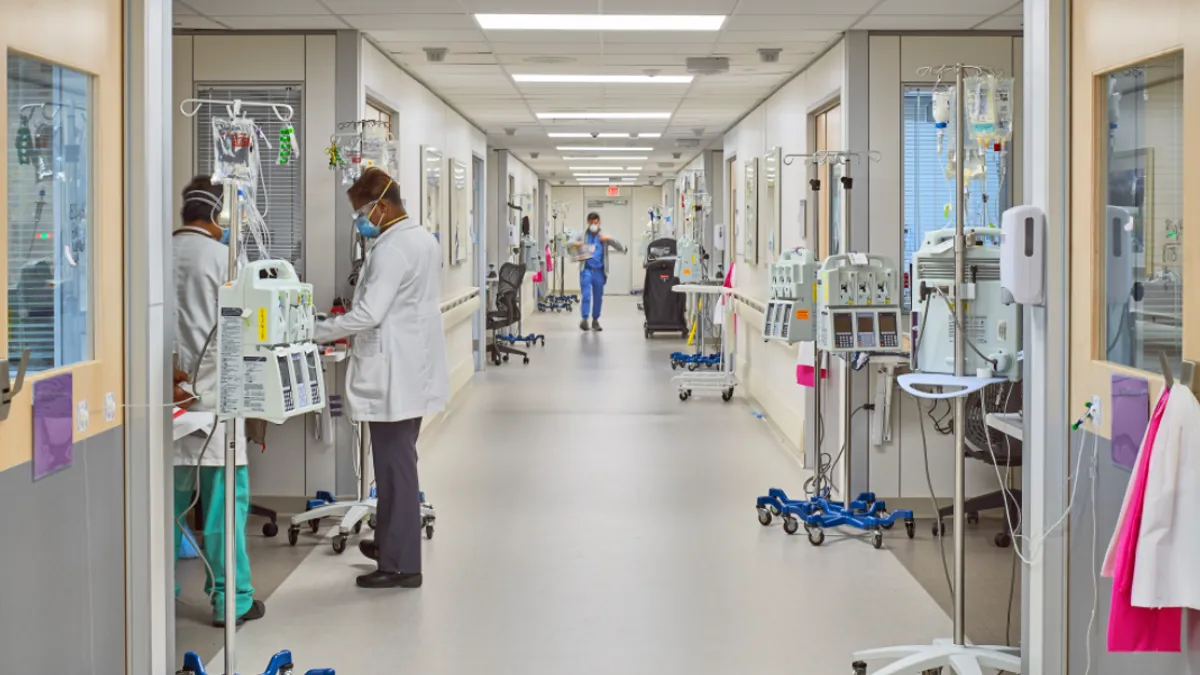Dive Brief:
- The already bleak financial situation for U.S. hospitals isn't improving, with margins down month over month and volumes and revenues continuing to fall across most metrics, according to Kaufman Hall's latest monthly flash report. Expenses also remained high compared to last year and above budget.
- Inpatient admissions were the only metric to rise, surpassing 2019 levels for the first time since the pandemic began as COVID-19 hospitalizations more than doubled in November. Discharges remained down, though, as higher-acuity patients, including those with COVID-19, ticked up average lengths of stay.
- The continued hit to hospital volumes will be a challenge for the medtech industry as well. J.P. Morgan analysts wrote that even as coronavirus vaccines rollout, a recovery for medical device companies is not likely until the second half of 2021 and into 2022 as further elective care and emergency room volume declines are expected. However, procedures like orthopaedics, spine and neuromodulation should come back more quickly than others.
Dive Insight:
Even amid signs of hope with COVID-19 vaccines rolling out, it will take months for protection to spread.
In the meantime holiday gatherings and cold weather are worsening the situation as case numbers continue to rise, Kaufman Hall's report that surveyed 900 hospitals warns.
Operating margins were down 16.4% in November from October and 11.6% year over year when funds from the Coronavirus, Aid, Relief, and Economic Security Act were excluded. With that money accounted for, operating margins fell 8.3% year over year.
The rapid uptick in inpatient admissions in November was unusual compared with recent monthly reports, as hospitals cared for sicker patients. Average lengths of stay were up 4.7% month over month in November and 8.7% year over year.
Emergency departments have struggled throughout the pandemic amid stay-at-home orders and patient reluctance, with admissions down 15.5% year over year. Those admissions also dropped 5.2% month over month in November.
Adjusted discharges fell 9.9% month over month and operating room minutes fell 10.2% month over month.
Similar with volumes, financial metrics were also mixed. Excluding CARES funds, gross operating revenue was up 4.2% year over year but down 3.8% year to date.
| Kaufman Hall Metrics | Year-over-year | Year-to-date |
| Gross Operating Revenue (excluding CARES funds) | 4.2% | -3.8% |
| Inpatient Revenue | 12.7% | -0.6% |
| Outpatient Revenue | -0.6% | -6% |
| Total Expense per Adjusted Admission | 17.3% |
14% |
Multiple rounds of relief grants have gone out to providers throughout the pandemic, serving as a lifeline for some while others have returned the money.
HCA, one of the largest for-profit operators, returned $6 billion it received through the CARES act in October. Later that month in its third quarter earnings it posted a $668 million profit, up 9% from the same time last year.
And major non-profit, Mayo Clinic, on Monday returned about half of its grant money — $156 million of the total $338 million it received, according to a spokesperson.
Congress approved another massive relief package Monday that includes $900 billion in new COVID-19 relief, this time emphasizing direct payments to individuals, loans for small businesses and enhanced unemployment benefits.
For healthcare, it includes a long-awaited ban on surprise medical bills, along with $22 billion for the health-related expenses of state and local governments and additional funding to boost the $175 billion provider relief fund along with funding to help distribute vaccines and establish a national COVID-19 testing and contact tracing system.














